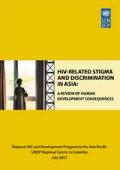Publications - Released in 2007
Although there have been many notable successes in both the prevention and treatment of HIV, stigma and discrimination have been intractable problems associated with the AIDS epidemic throughout the world. Stigma certainly has well-established individual consequences: it has been shown to delay HIV testing, restrict utilization of preventative programs, and hinder the adoption of preventative behaviours like condom use and HIV status disclosure (Brooks et al., 2005). Stigma may also have consequences for individual economic well-being as well as broader socioeconomic development (beyond the impact of HIV disease alone). In Asia, where the epidemic arrived relatively late, HIV is spreading with rapid speed. In 2005, the number of AIDS cases in Asia topped 8 million; this is compared to approximately 3 million people just 10 years prior (UNAIDS, 2006). Determinants and consequences of stigma and discrimination on socioeconomic development in Asia have yet to be empirically assessed.
In this context, this review is aimed at generating informed discussion among key stakeholders including academia, policy makers, governments, donors and people living with HIV on the phenomenon of stigma and discrimination, with a particular focus on its human development context and impact. The paper also seeks to set a research agenda to foster compelling and disaggregated enquiries into stigma and discrimination.
Downloads
Organizations
- United Nations Development Programme (UNDP)






